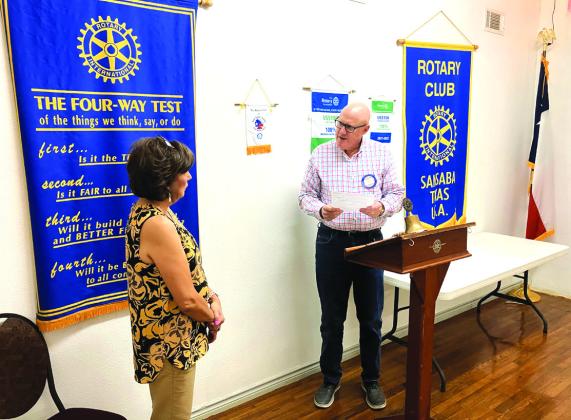The regularly scheduled weekly meeting of the San Saba Rotary club was held Thursday noon at Pepperbelly's. The club meetings, both business and program combined, do not exceed one hour in length.
Sergeant of Arms Tom Griess inducted Dora Cisneros Miller as a member and welcomed her return after a hiatus of several years. Ms. Miller, well-known in San Saba as a staunch community member, is an active supporter of Rotary.
The club, whose business and program, does not exceed one hour and who encourages guests who might desire to join the group, invited President Beth Griess to speak regarding Texas Dark Skies. Ms. Griess presented an informative PowerPoint presentation on the Lampasas County organization Friends of the Night Sky. Multiple Central Texas counties like neighboring Lampasas County, in response to McDonald Observatory requests and including various Texas cities and communities of both large and small organizations, have responded by advocating for limiting light pollution of Texas night skies. Six area counties have resolved to make their counties and communities be night sky friendly and to eliminate or reduce nighttime light pollution!
Vast numbers of Americans and others from throughout the world have never seen the Milky Way or the Southern night sky because of urban lights. In addition, Americans and others in cities and as well as in rural areas, mistakenly believe that security equals bright glaring lights when in fact bright lights can encourage graffiti, break-ins, and false security. Many rural ranches in Texas and the US mistakenly announce their locations by bright lights and invite unwelcome visitors when lowered lighting and/ or better still, movement sensor lighting would increase security, save on expensive lighting and contribute to darkened skies.
Sadly, bright night lighting has been found to contribute to confused bird migratory patterns, wildlife which is becoming conditioned to lights and encroaching on urban areas, and amphibians and other animals like toads being threatened because of the light pollution. Because of excessive blue white lighting from computers, cell phones, and environmental light pollution, human natural circadian rhythms are being interrupted causing chronic sleep deprivation, insomnia, and a myriad of health issues.
Solutions to the pollution can be as simple as throwing lights down with some kind of shade, using shaded yellow lights as opposed to blue white lights, covering over invasive lights or even partially painting lights which can cause us to resent our neighbors whose lighting invades our homes.
Sedona, Arizona, interestingly, is an area that has capitalized on dark sky tourism and encourages the use of little or no lighting while attracting visitors to the majesty of the vast star filled desert sky. The goal of many such dark sky advocates is to have no lights at all except as necessary for immediacy. Again, strategies like movement sensors allow brief lighting as needed but returning to darkness.
Ms. Griess encourages San Sabans to consider joining neighboring counties in seeking resolutions to move our area toward dark skies.
Submitted by Rotary Member.

